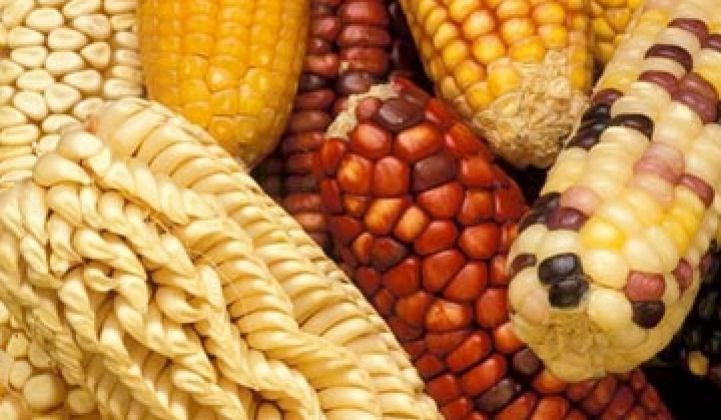Corn is dead. Long live corn?
The last few years have been brutal for corn ethanol producers, largely because of high corn prices and lower gasoline prices. In 2008-2009, at least twelve major ethanol companies filed for bankruptcy, including the second largest producer, VeraSun.
But on January 8, 2010, Pacific Ethanol announced that its 60-million-gallon per year facility in Burley, Idaho had resumed production after being shuttered for a year. The company's stock jumped from $0.75 to $2.75 within days.
Is the Pacific Ethanol announcement an aberration or a harbinger of better times, at least in the near future? An unusual set of circumstances indicate that corn ethanol just might see brighter days soon.
Last week, the Department of Agriculture reported the largest fall corn harvest on record, totalling 13.151 billion bushels. As a result of the bountiful harvest, spot corn prices have dropped to $3.58/bu. This compares favorably to past dips, as when corn prices hit $7.88/bu in mid-2008 and the $4.25/bu prices that were prevalent just a few weeks ago.
Factoring in that Dried Distiller Grains Solubles (DDGS --- a co-product of ethanol production) can be sold at $35/ton, we estimate that the current industry cost of producing a gallon of ethanol is $1.54/gal.
If the national wholesale price of ethanol is currently $1.79/gal, we see that corn ethanol producers have a margin of approximately $0.25/gal. Although the retail price of E85 ethanol (containing 85% ethanol and 15% gasoline) is selling at a discount to the national average retail gasoline price ($2.27 vs. $2.71), when we factor in that a gallon of E85 has only 72% of the amount of BTU energy content as a gallon of gasoline, we find that for E85 to have true price parity with gasoline, it would need to sell for $1.95/gal. Yet, since the overwhelming majority of ethanol is used as a blend rather than in dedicated E85 pumps, ethanol producers are also buoyed by the $0.45/gallon "blender's credit" provided to refiners for purchasing corn ethanol.
Major oil companies like Valero and Sunoco have been swooping up these bankrupt producers' assets for pennies on the dollar, partially to internalize this blender's credit. In addition to improved margins, pre-existing corn ethanol producers are assisted by the mandates included in the Energy Independence and Security Act of 2007 that require the petroleum industry to blend 12 billion gallons of corn ethanol in 2010. This mandate effectively creates a market floor for ethanol producers.
Additionally, by mid-2010, the EPA is set to rule on whether it is safe for unmodified gasoline engines to consume gasoline that contains more than 10% ethanol. Factors such as demand, beneficial regulations, "cheap" manufacturing capacity though fire sales, and declining feedstock and natural gas prices could all act as catalysts for corn ethanol growth.
Not everyone is a fan of first-generation corn ethanol. The ever-expanding pool of industry critics like to point out that in 2010, the U.S. will utilize close to 33% of its entire corn crop to grow a fuel that only displaces about 5% of our gasoline consumption. Additionally, the California Air Resource Board (CARB) recently ruled that, when considered on a life-cycle analysis basis that includes "indirect land use" effects (i.e., peat forests in Indonesia being cut down to grow food crops that would otherwise be grown in the U.S.), each gallon of corn ethanol produces more GHG than petroleum.
Ethanol is also largely incompatible with most of the pre-existing petroleum infrastructure--it can't effectively be shipped in pipelines, and only a fraction of gas stations already offer E85 pumps. What's more, each gallon contains only two-thirds of the energy found in a gallon of gasoline.
Although advanced biofuels like second-generation cellulosic ethanol are on the cusp of commercialization, it seems that, for better or for worse, the near-term prospects for first-generation corn ethanol producers may be looking up.



